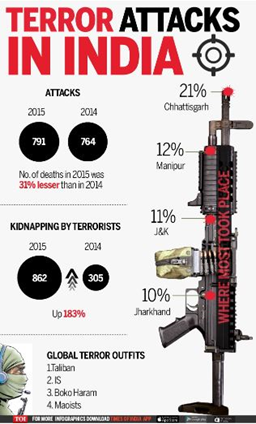Distortion of Muslim population figures in India
This post has three articles
1) Five charts that puncture the bogey of Muslim population growth
2) Census data by religion: Growth rates of all religious communities in India are falling
3) Minority report: Muslim families shrinking fastest among Indian communities
Five charts that puncture the bogey of Muslim population growth
From Muslims overtaking Hindus to Bangladeshi immigration, much of the right wing’s rhetoric on demographics is belied by data.
A report released last week by the Pew Research Center predicting that India will overtake Indonesia as the country with the largest Muslim population has set off the usual suspects. In response, the Vishwa Hindu Parishad on Saturday asked Hindus to have more children to rectify this “demographic imbalance” and predicted that soon Muslims will overtake the number of Hindus in India.
This is nothing new, of course. Malthusian fears of a Muslim takeover of India have been a core part of the Hindutva agenda for almost a century now. After the 2002 Gujarat pogrom, for example, Narendra Modi characterised the violence-affected Muslims in riot camps as “baby-producing factories”. After he formed the government at the Centre, these fears have come to the fore in the form of pronouncements by various Bharatiya Janata Party leaders who want Hindu women to have greater numbers of children in order to boost the community’s numbers. In January, just before the Delhi assembly elections, the 2011 Census’ figures on religion were conveniently leaked to newspapers.
Unfortunately, these feverish demographic projections generate far more heat than light. As the charts below show, actual data on this issue would hardly support the sort of fears that the Sangh Parivar plays up.
Bogey #1: Muslims will overtake Hindus
This is an extremely popular notion in the Sangh Parivar. Before the Vishwa Hindu Parishad’s statement on Saturday, this was last bought up in February by the Bharatiya Janata Party’s Sadhvi Prachi, who accused Muslims of giving birth to “40 dogs” each and “trying to convert Hindustan into Darul Islam”. Drumming up of fears of a minority swamping a majority is standard right wing political strategy and it is no different in India.
Indeed, Muslim population growth rates are higher than the corresponding figure for the Hindu community. If one were to accepted that the leaked figures from the 2011 Census are accurate, Hindus grew at an average annual rate of 1.4% between 2001 and 2011. For Muslims, the corresponding figure was 2.2%.
If we assume both communities continue to grow at this rate, Muslims will catch up with Hindus by 2220 ‒ in around 200 years.
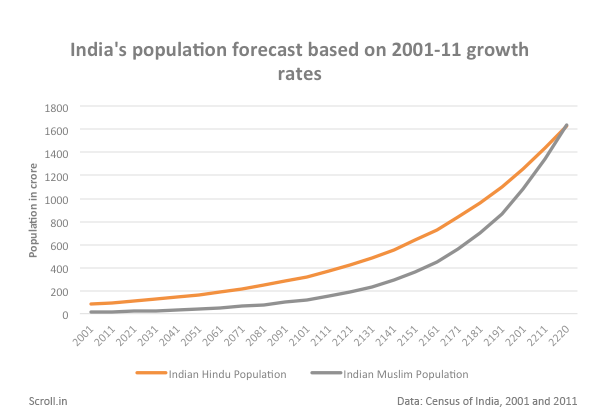
Data: Census of India, 2001 and 2011.
Accepting these growth rates, at the time Muslims outnumber Hindus, India’s population will be 3,264 crore. Now you know that is a lot of people but let’s see just how much.
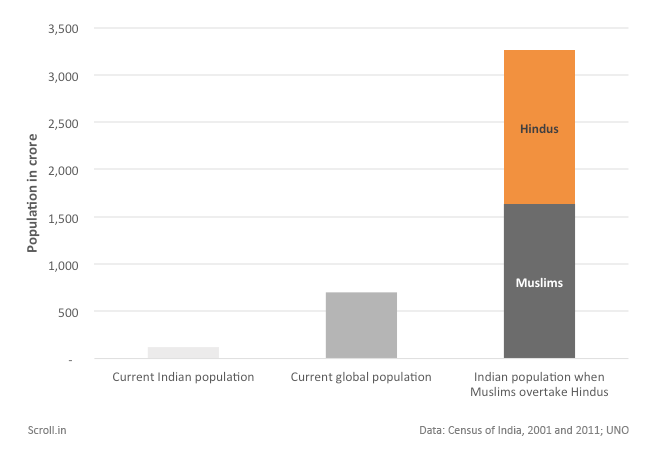
Data: Census of India, 2001 and 2011.
At these rates, for Muslims to overtake Hindus, India’s population would need to be almost five times the current global population. In other words, this is clearly an impossible scenario.
More logically, at some point in the future, Muslim growth rates will slow down and the population will stabilise. This, in fact, is already happening. While from 1991 to 2001, the Indian Muslim population grew by 29.3%, in the period 2001-2011, it grew by 24.4% – a fall, therefore, of almost 5 percentage points.
The Sachar Committee Report, taking this falling growth rate into account, has estimated that the Muslim proportion will stabilise at between 17% and 21% of the Indian population by 2100. A far cry from some of the doomsday scenarios being painted.
Bogey #2: The Muslim growth rate is abnormal
The extremely poor economic conditions of Muslims in India are cited by many liberals and left wingers as the prime reason for their high population growth rate. However, the Hindutva explanation for this growth, expectedly, blames religious factors and dismisses the economic drivers. To quote Hindutva Indologist, Koenraad Elst: “Muslims will have a markedly higher birth rate than their Hindu counterparts, even to the extent of having a higher birth rate than Hindus in a lower educational or income bracket.”
The data tells a different story.
As this chart below shows, depending on how you segment the data, a number of other disadvantaged population groups have growth rates similar to the Muslim growth rate.

Data: Census of India, 2011.
Moreover, since Muslim infant mortality is lower than other population segments, this effect can even be seen in the Total Fertility Rate (or number of births per woman).
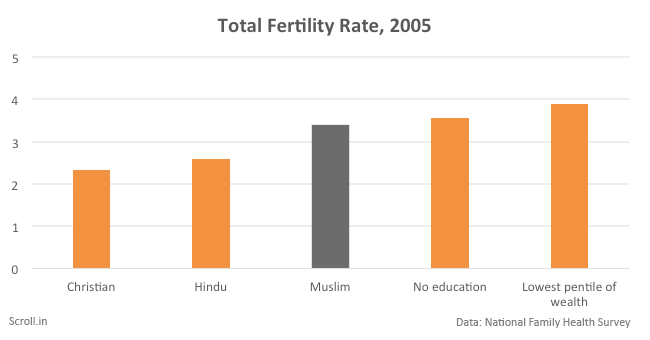
Data: National Family Health Survey.
The Muslim Total Fertility Rate is, as expected, higher than that for Hindus and Christian. But when we segment the population socio-economically, we see that Muslims manage to be better off than people without any education or the poorest fifth of India’s population by wealth.
Clearly then, economic and educational factors seem to the major driver at play here.
We could also disprove the Hindutva groups’ religious argument by looking at the global scene. Iran, for example, achieved replacement level fertility (with each new generation being less populous than the one before) in 2002, a goal India will only reach in 2020. With a population that is more than 90% Muslim, Bangladesh has a TFR not only lower than India’s overall but also lower than India’s Hindus.
Bogey #3: Bangladeshi Immigration
Accusations of large-scale Bangladeshi immigration are a hot-button issue for the right wing now, another supposed driver of the alleged Muslim population boom, along with polygamy (which in itself is untrue). So critical, in fact, that Modi thought that the Assam government was culling rhinos in order to make way for immigrants.
If, as alleged, such large-scale immigration was taking place from Bangladesh to Assam and West Bengal, the Muslim population in those two states would tend to show abnormal growth. But the data shows nothing of that sort.
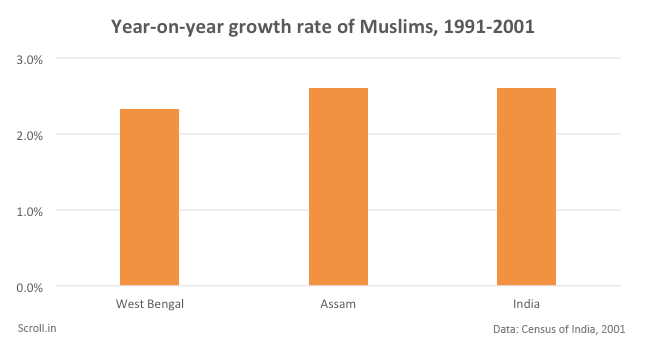
Data: Census of India, 2001.
Assam’s Muslim population, for example, grew at the same rate as India’s Muslim population between 1991 and 2001 and West Bengal’s Muslim population, in fact, grew slower. The abnormal growth rate that Assam’s and West Bengal’s Muslim populations should show, given the alleged massive Bangladeshi immigration, simply has not happened.
In the rough and tumble of India’s politics, religious rhetoric often goes a long way electorally. It is therefore not surprising that, in spite of the mountains of contrary data, the Sangh Parivar’s demographic scaremongering has managed to achieve a significant amount of traction
SOURCE:- http://scroll.in/article/705283/five-charts-that-puncture-the-bogey-of-muslim-population-growth
Census data by religion: Growth rates of all religious communities in India are falling
At this rate, Muslims will take 270 years to outnumber Hindus.
by Dilip D’Souza
A few years ago, someone sent me an article he had just written. By way of introduction, he called himself an “accomplished nuclear physicist”, and also an “expert on Islamic fundamentalism”. This was appropriate, because the article purported to be an analysis of the threat that Islamic fundamentalism posed to India. It was, instead a comical mishmash of paranoia, lies and twisted statistics that any self-respecting editor should have torn up pronto.
But one sentence in this feverish screed, in particular, has stuck. The Muslim population in India, said the expert, had increased so fast and to such an extent that “non-Muslims now rarely venture into areas of India where Muslims are in large numbers, fearing unpredictable, irrational behaviour or violence directed at them”.
This is what qualifies, in some quarters, as analysis.
The nuclear physicist likely thinks he has new ammunition for his wayward gun: The Census Commissioner has just released population data by religion from the 2011 Census of India.
What will draw his attention ‒ and that of any number of other fear-mongers across this country ‒ are the growth figures for the different religious communities in the decade ending in 2011. In those ten years, the Hindu population increased by 16.8%, Muslim by 24.6%, Christian 15.5%, Sikh by 8.4%, Buddhist 6.1% and Jain 5.4%. This means that 79.8% of Indians are Hindu ‒ apparently the first time that fraction has dipped below 80% ‒ and 14.2% are Muslim, with the other faiths making up tiny slices of the population pie.
Fear-mongers will point fearfully at the Muslim figures and scream in panic:
Of course, this is what fear-mongers do. For the less fearful among us, here are just four numbers to chew on. Two are a repeat: between 2001 and 2011, Hindu and Muslim numbers increased by 16.8% and 24.6%, respectively. But what about the previous ten years ‒ between 1991 and 2001? In that decade, Hindu and Muslim numbers increased by 19.9% and 29.5%, respectively. (See my previous article on this subject here.)
Any way you look at those four numbers, two conclusions are inescapable: both growth rates are decreasing, and the Muslim growth rate declined faster than the Hindu growth rate.
In that previous article, I used the 1991-2001 numbers to deduce, via some elementary arithmetic, that at those growth rates, “it will be nearly 220 years before the Muslim population equals the Hindu population”. If we use the 2001-2011 numbers in the same way, we find that for the Muslim population to equal the Hindu population, we will have to wait nearly 270 years. Stack 220 up against 270 to know that, again, the Muslim growth rate is declining faster than the Hindu growth rate. And if population parity itself frightens you, at least consider that the mongers are talking of something that might happen in (drumroll, please) … 2285 AD.
And in fact it won’t happen. For if we do maintain these 2001-2011 growth rates ‒ again repeating calculations from that previous article ‒ in 2285 AD we’ll have nearly 64 billion Hindus and 64 billion Muslims in this country. Or actually we won’t: we’ll have long crowded ourselves to death by then. That’s the only way we will manage any “EXTINCTION”.
So here’s the only sensible deduction to make from the Census figures: population growth rates will slow across the board, leading eventually to a stable population and then to a decline in numbers.
Even the accomplished nuclear physicist should be able to understand that. Except, he prefers fear-mongering.
SOURCE:- http://scroll.in/article/751073/census-data-by-religion-growth-rates-of-all-religious-communities-in-india-are-falling
Minority report: Muslim families shrinking fastest among Indian communities
Indian families are getting smaller and the decline is sharpest among Muslims, religious census data released on Friday said, in what could be signs of rising literacy levels in the community.
The report of the census carried out in 2011 was released almost a year after the government revealed religion-wise population figures from the same year.
The latest data said the country’s average family size in 2011 was 4.45 members, down from 4.67 a decade earlier, a drop of 5.3%.
In the Muslim community the average family size fell from 5.61 to 5.15, the report released by the home ministry said. The reduction was sharper — 11.1% — for Muslim households headed by men while for families headed by women it was 4.47%.
The Muslim community is often targeted by Hindu right-wing groups of having large families and a higher population growth rate. Last year, BJP parliamentarian Sakshi Maharaj and Vishwa Hindu Parishad (VHP) Sadhvi Prachi had separately asked Hindu women to bear at least four children to counter the growth in Muslim population.
Religious population data released last year showed that the community grew by 24.6 percent between 2001 and 2011. At 17.22 crore, the community formed 14.2% of India’s 121 crore population. With a population of 96.63 crore, Hindus constitute 79.8% of the population.
Data released on Friday also showed the average size of Hindu families declined by 5.02% over the decade, Christian households by 6.47%, Sikh by 7.44%, Buddhist by 5.96% and Jain by 5.5%.
The average household size was higher in male headed households as compared to those headed by females across all religious communities.
Overall, “Christians had the highest percentage of households headed by females (17.4%) followed next by Buddhist (15.9%). The lowest percentage of female headed households is in Jain community (11.5%),” the report said.
The data showed that the difference in household size between different religious communities wasn’t as big as was often made out. Besides, the continuing decline has also narrowed the gap in family size between different religious communities.
In 2011, the average size of a Hindu family was 4.35. In contrast, a Muslim household had 5.15 members, a Christian household 4.05, Sikh household 4.85, Buddhist household 4.1 and a Jain household 4.45 members.
In 2011, an average Muslim family just had 0.8 more persons than a Hindu household as compared to 1.03 persons in 2001.
Source: http://www.hindustantimes.com/india/minority-report-muslim-families-shrinking-fastest-among-indian-communities/story-hkO5699sGJUFEcYGBEmmrM.html
